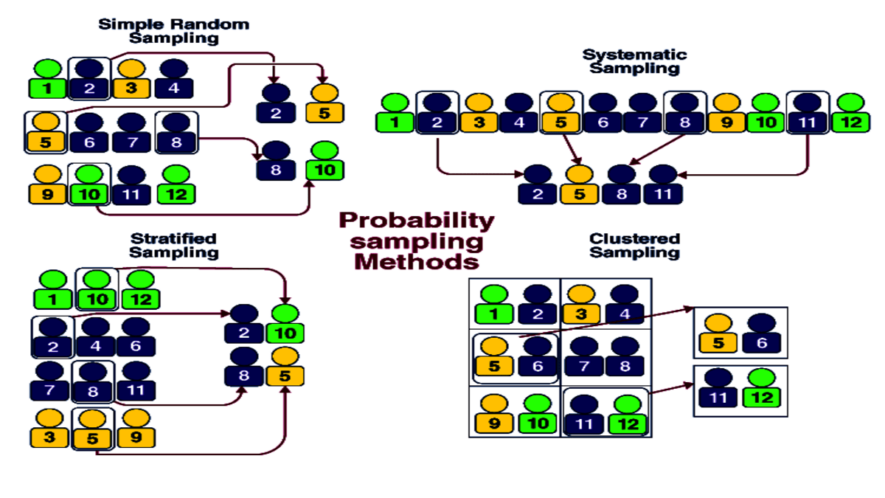Sampling Technique
The sampling technique, or the sampling method, is a statistical approach used for selecting a representative sample from a population. It involves rigorous analysis of the data gathered about population and selecting an appropriate sample on the basis of data.
There are several different sampling techniques available which can be classified into two major categories.
- Probability Sampling Techniques
- Non-Probability Sampling Techniques
Probability Sampling Techniques
The probability sampling technique uses some sort of random selection. In this method, every individual of the population has an equal chance of being selected. The advantage of using probability sampling is that probability sampling gives us the best chance to draw a sample that is true representative of the population. However, this method is more time consuming and expensive than the non-probability sampling method.
Probability sampling methods are further divided into different types, which are as under.
1. Random Sampling
Random sampling is generally the best and simplest way to draw a sample from a population. With random sampling, every member of the population has an equal opportunity to be included in the sample, and pure chance is the only factor that determines who actually goes into the sample. It is used to eliminate bias, both conscious and unconscious, that researchers might introduce while selecting a sample.
For example, we want to choose 200 students at random from a school. Here, we can give each student in the database of the school a number between 1 and 500 and choose a random sample of 200 numbers using a random number generator. Another example is going to a shopping mall and asking every fifth person for his or her opinion about inflation.
2. Stratified Sampling
A researcher uses stratified sampling technique when he/she has distinguished, and well identified subgroups (Strata means subgroups, subsets (single: stratum)) in the population. It is a procedure for selecting a sample that includes the individuals from identified subgroups in the proportion that they exist in the population. This method can be used to select equal numbers from each of the identified subgroups if comparisons between subgroups are important.
A good example of stratified sampling would be to divide the population into male and female or into rural and urban etc. It is useful only when you plan to subdivide the subjects for subsequent analysis to make various comparisons and decisions.
3. Cluster Sampling
Cluster sampling often is more convenient when the population is very large. It often isn’t possible to randomly select from the entire population but is more manageable when using clusters because of time, expense, and convenience.
For example, a university has ten campuses across the country, each with nearly the same number of students. We can’t travel to every unit in order to gather the necessary data if we want to gather some information on facilities and other stuff. Therefore, we can choose three or four branches as clusters using random sampling. This can help the researcher cut down on travel, expense, time, etc.
4. Systematic Sampling
In systematic sampling, the first member of sample is chosen randomly, and the others are selected according to a predetermined sampling interval (i.e., nth number). The sampling interval (i.e., nth number) is calculated by dividing the total population size by the desired sample size.
For example, a researcher wants to select a sample of 15 students from a total population of 150 students in a school. He/she will randomly choose first student from the list and then will systematically choose every 10th student. Finally, he/she will end up with a desired sample size.
Non-Probability Sampling Techniques
The non-probability sampling method is a technique in which the researcher selects the sample based on subjective judgment rather than the random selection. In this method, all elements do not have an equal chance of being selected. Consequently, there is a significant risk of ending up with a non-representative sample which does not produce generalizable results.
Non-probability sampling methods are further divided into different types, which are as under.
1. Convenience Sampling
A sample of convenience is the terminology used to describe a sample in which elements have been selected from the target population on the basis of their accessibility or convenience to the researcher.
Convenience samples are sometimes referred to as ‘accidental samples’ for the reason that elements may be drawn into the sample simply because they just happen to be situated administratively, near to where the researcher is conducting the data collection. Hence, this approach is also called ‘man-on-the-street’ sampling.
2. Purposive Sampling
In purposive or judgmental or authoritative sampling, we sample with a purpose in mind. We usually have one or more specific predefined groups we are seeking, and the sample is thus selected to include people of interest and exclude those who do not suit the purpose. Purposive sampling can be very useful for situations where you need to reach a targeted sample quickly and where sampling for proportionality is not the primary concern. With a purposive sample, you are likely to get the opinions of your target population.
This approach is also called judgmental sampling because the researcher makes expert judgments to select the sample which best suits the research study. For example, a researcher while conducting a research study on curriculum development may include only those teachers in the sample who are certified and trained by Curriculum Bureau.
3. Quota Sampling
Quota sampling provides a way to give respectability to a non-random sample. If done well, quota sampling can lead to strong inferences. When using this strategy, researchers identify important characteristics that they already know the target population possesses, and then they select the non-random sample in such a way as to make it correspond to the population with regard to these known characteristics.
Let us assume that we need to know about the career goals of university students. More particularly, the differences in the career goals among fresher, juniors and seniors are to be examined. Suppose the concerned university contains 10,000 students and can be taken as our population.
Now, we have to divide our population of 10,000 students into categories such as freshers, juniors and seniors. Suppose we find that there are 3000 freshers (30%), 2500 junior students (25%) and 2000 senior students (20%). Our sample must have these proportions. It means that if we sample 1000 students, then we must consider 300 freshers, 250 juniors and 200 seniors. Lastly, we may start collecting samples from these students based on our proportion.
4. Snowball Sampling
In snowball or chain-referral sampling, you begin by identifying someone who meets the criteria for inclusion in your study. You then ask them to recommend others who they may know who also meet the criteria. Snowball sampling is especially useful when you are trying to reach populations that are inaccessible or hard to find.
For instance, if you are studying the homeless, you are not likely to be able to find good lists of homeless people within a specific geographical area. However, if you go to that area and identify one or two, you may find that they know very well who the other homeless people in their vicinity are and how you can find them.
OTHER RELATED POSTS



